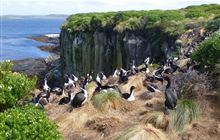First step towards NZ’s largest pest-free island
Archived content: This media release was accurate on the date of publication.
Introduction
Conservation Minister Eugenie Sage has announced funding for the first step in New Zealand’s most ambitious island pest eradication.Date: 23 June 2018
Speaking at Forest and Bird’s 2018 Conference, the Minister committed $2 million over the next three years to complete planning, including field trials, towards making subantarctic Auckland Island predator free.
“This is an ambitious project on the 46,000 ha Auckland Island and a major step towards the goal of New Zealand being predator free by 2050,” Eugenie Sage said.
“The funding will allow greater understanding of the scale and complexity of the problem and help guide decisions about eradicating pigs, cats and mice from Auckland Island.
“Any decision to proceed will require a long-term commitment of resources and effort. Early estimates suggest the potential cost of eradication may be in the order of $40 million to $50 million over eight to 10 years.
“The Department of Conservation is working closely with iwi partner Ngāi Tahu and will be seeking other partners to collaborate on the project,” Eugenie Sage said.
Introduced pigs and cats have devastated Auckland Island’s native wildlife and plants. Mice are also a problem by competing for food with native birds, and attacking seabird chicks.
Most of the native birds that were once abundant on Auckland Island have disappeared from the main island and now exist only on the surrounding pest-free islands. These include the Auckland Islands snipe, Auckland Island rail and Auckland Island teal.
“Eradicating these pests from New Zealand’s fifth-largest island would see Auckland Island become the country’s largest pest-free island. It would complete the removal of introduced predators from all of New Zealand’s sub-Antarctic islands, cementing our reputation as a world leader in predator control,” Eugenie Sage said.
More information
Auckland Island at 46,000 ha is the main island of the subantarctic Auckland Islands, and is the largest and biologically richest archipelago of the five island groups that make up New Zealand’s subantarctic islands. They have been a World Heritage Site since 1998.
As one of the few large land masses in the Southern Ocean, the Auckland Islands are a breeding ground of critical importance to many species of seabirds and marine mammals and this unique wildlife is in peril from pigs, cats and mice. There are 25 seabird species breeding on the Auckland Islands
The Auckland Islands are most important as a nesting site for the following seabirds:
- Lesser fulmar prion (Pachyptila crassirostris flemingi)
- Auckland Island shag (Leucocarbo colensoi)
- Yellow-eyed penguin (Megadyptes antipodes)
- Gibson’s albatross (Diomedea antipodensis gibsoni)
- White capped albatross (Thalassarche cauta steadi)
The vision for a pest-free New Zealand subantarctic islands builds on previous eradication success in the region: Auckland Island (goats by 1992), Enderby Island (rabbits and mice 1993), Rose Island (rabbits in 1993), Campbell Island (rats in 2001) and more recently Antipodes Island (mice in 2016). No mammalian pests are on the Snares and Bounty Islands.
The $2 million feasibility funding comes from the Budget 2018 pest control four-year appropriation of $81.3 million aimed towards achieving a predator free New Zealand by 2050.
Contact
For media enquiries contact:
Email: media@doc.govt.nz

